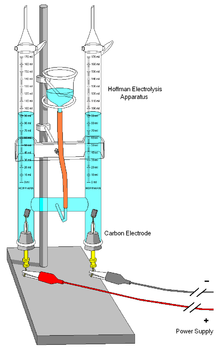Etymology and History of Electrolysis
- The term 'electrolysis' was introduced by Michael Faraday in 1834.
- The word is derived from the Greek words ἤλεκτρον and λύσις, meaning amber and dissolution, respectively.
- William Nicholson and Anthony Carlisle observed the production of hydrogen and oxygen through electrolysis in the early 19th century.
- Martin van Marum unknowingly produced electrolysis in 1785 while using an electrostatic generator to reduce tin, zinc, and antimony.
- Luigi Galvani's experiments with frog legs led to Alessandro Volta's tests on the generation of electricity through dissimilar metal sheets.
- Humphry Davy conducted preliminary experiments on electrolysis and hypothesised the release of electrical energy during the formation of compounds.
- Johan August Arfwedson discovered lithium in 1817, and William Thomas Brande used electrolysis to isolate it in 1821.
Overview and Process of Electrolysis
- Electrolysis involves the passing of a direct electric current through an electrolyte, resulting in chemical reactions and decomposition.
- The main components required for electrolysis are an electrolyte, electrodes, and an external power source.
- An ion-exchange membrane or salt bridge can be used as a partition to prevent diffusion of products.
- The electrolyte contains free ions and conducts electric current.
- Electrodes can be made of metal, graphite, or semiconductor materials, depending on reactivity and cost.
- Electrolysis involves the interchange of atoms and ions through the removal or addition of electrons.
- The desired products of electrolysis are often in a different physical state from the electrolyte and can be separated mechanically.
- The quantity of products is proportional to the applied current.
- Faraday's laws of electrolysis state that the products produced in electrolytic cells connected in series are proportional to their equivalent weight.
- Positively charged ions (cations) move towards the cathode, while negatively charged ions (anions) move towards the anode.
Variations and Applications of Electrolysis
- Pulsating current leads to different products compared to DC.
- Pulsing increases the ratio of ozone to oxygen produced in electrolysis of aqueous acidic solutions.
- Electrolysis of ethanol with pulsed current evolves an aldehyde instead of an acid.
- Galvanic cells and batteries use redox reactions to generate electrical potential.
- Secondary batteries can be considered as electrolytic cells when charged.
- Hall-Héroult process is used for producing aluminium.
- Electrometallurgy is used for producing various metals such as lithium, sodium, and potassium.
- Chloralkali process is used for producing chlorine and sodium hydroxide.
- Electrofluorination is used for producing perfluorinated organic compounds.
- Electrolysis is used for purifying copper, producing fuels like hydrogen, and removing rust.
Research Trends in Electrolysis
- Electrolysis of carbon dioxide can produce value-added chemicals such as methane, ethylene, and ethanol.
- Electrolysis of acidified water produces hydrogen and oxygen in a 2:1 ratio.
- Carbon/hydrocarbon assisted water electrolysis (CAWE) process utilizes carbon or hydrocarbon to reduce energy input in hydrogen generation.
- Electrocrystallization is a specialised application of electrolysis used to obtain conductive crystals.
- Electrolysis of iron ore can eliminate direct emissions in steel production if electricity is created from green energy.
Electrolysis of Seawater
- Direct electrolysis of seawater has been investigated as a method for hydrogen generation.
- Different electrolysis technologies, including alkaline electrolysis and proton-exchange membrane electrolysis, have been studied.
- Proton-exchange membrane electrolysis offers a suitable combination of economic operation costs, environmental considerations, and safety.
- Solid oxide electrolysers require high temperatures to operate but suffer from degradation when turned off.
- Multiple-criteria decision analysis has been used to evaluate the performance of different electrolysis methods.
In chemistry and manufacturing, electrolysis is a technique that uses direct electric current (DC) to drive an otherwise non-spontaneous chemical reaction. Electrolysis is commercially important as a stage in the separation of elements from naturally occurring sources such as ores using an electrolytic cell. The voltage that is needed for electrolysis to occur is called the decomposition potential. The word "lysis" means to separate or break, so in terms, electrolysis would mean "breakdown via electricity".

Coined by English polymath William Whewell in 1834 for Michael Faraday. From electro- + -lysis (“a loosening”). Originally of tumors, later (1909) of hair removal.
electrolysis (countable and uncountable
... Read More